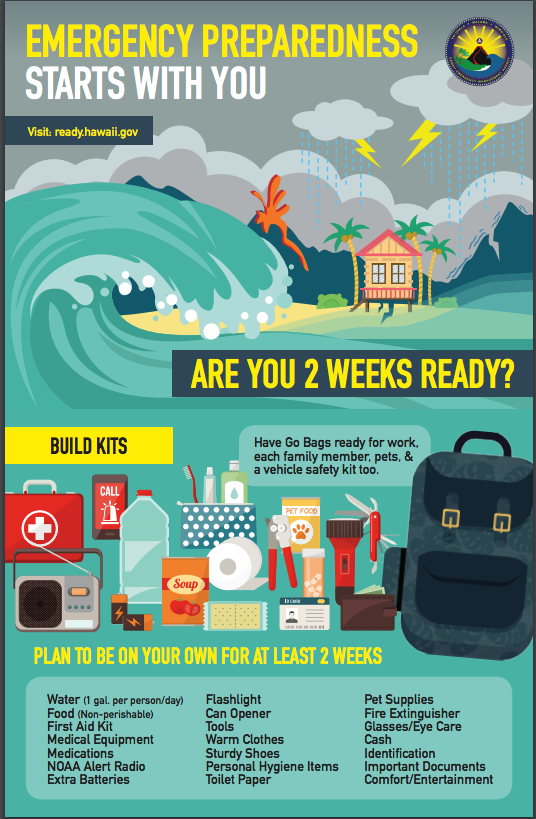

The three most important things? Save a list of Hawaii Hurricane Resources to your phone or print it out, get cash and fill your car with gas.
#Hurricane preparedness checklist hawaii how to#
( Click here to find out how to prepare for a hurricane in Hawaii.) Here are a few top tips on how you can keep your family safe during hurricane season. Family, homes, possessions, pets, they all need to be taken care of and prepared for before the hurricane arrives. That gives us just a couple of days to make sure that our families and homes are as prepared as they can be, before the hurricane strikes. we usually have a few days warning before the tropical wrath hits us. Hurricanes can happen at any time of the night or day, but they do have one advantage for us which we don’t often have over things like earthquakes, tornadoes and other natural disasters. This section will contain a summary of the most important hurricane disaster plan items to do before bad weather strikes. Short Term Watches and Warnings: These warnings provide detailed information about specific hurricane threats, such as flash floods and tornadoes.Top Tips To Keep Your ʻO hana Safe During a Hurricane – Including The Three Most Important Things You Must Do Before The Hurricane Arrives And Four Things You Should Buy For Your ʻO hana/Family Take immediate shelter in the interior portion of a well-built structure. Complete storm preparations and immediately leave the threatened area if directed by local officials.Įxtreme Wind Warning: Extreme sustained winds of a major hurricane (115 mph or greater), usually associated with the eye wall, are expected to begin within an hour. Hurricane/Tropical Storm Warning: Hurricane/tropical storm conditions are expected in the specified area of the warning, usually within 36 hours of the onset of tropical storm force winds. Tune in to NOAA Weather Radio, commercial radio, or television for information. Hurricane/Tropical Storm Watch: Hurricane/tropical storm conditions are possible in the specified area of the watch, usually within 48 hours. Storm Tide: A combination of a storm surge and the normal tide (i.e., a 15-foot storm surge combined with a 2- foot normal high tide over the mean sea level created a 17-foot storm tide). Storm surge is by far the greatest threat to life and property along the immediate coast. Storm surges can reach 25 feet high and be 50–1000 miles wide. Storm Surge: A dome of water pushed onshore by hurricane and tropical storm winds. Hurricane: An intense tropical weather system of strong thunderstorms with a well-defined surface circulation and maximum sustained winds of 74 MPH (64 knots) or higher. Tropical Storm: An organized system of strong thunderstorms with a defined surface circulation and maximum sustained winds of 39–73 MPH (34–63 knots). Sustained winds are defined as one-minute average wind measured at about 33 feet (10 meters) above the surface. Tropical Depression: An organized system of clouds and thunderstorms with a defined surface circulation and maximum sustained winds of 38 MPH (33 knots) or less. It is a good idea to develop a plan of action for your business and your staff to be ready for this type of interruption. Businesses located within areas of risk should have a hurricane preparedness plan. The scale categorizes storms according to their sustained winds, the storm surges produced, and expected damage. The National Weather Service rates hurricanes by their intensity, using the Saffir-Simpson Hurricane Wind Scale of one to five. You should also prepare for these potential interruptions. Though coastal regions are always the most vulnerable to a Hurricane’s effects, flooding and tornadoes may affect areas well inland. A rare, but sometimes deadly effect of Hurricanes can be tornadoes spawned by the larger storms. Hurricanes can also generate heavy rainfall, another cause of severe flooding over wide areas. In flat areas, storm surges and extremely high tides may force water many miles inland. When the National Oceanic and Atmospheric Administration’s National Hurricane Center issues a watch or warning, use the time available to begin taking the following steps. This checklist will help you prepare for a hurricane’s effect on your organization, employees and community by highlighting activities you should undertake before, during, and following the event. However the majority of lives lost and property destruction is actually caused by storm surge & flooding. The most obvious is the threat posed to buildings, equipment, and people by the high winds which characterize such storms.
#Hurricane preparedness checklist hawaii series#
Hurricanes generate a series of threats to lives and property.


 0 kommentar(er)
0 kommentar(er)
